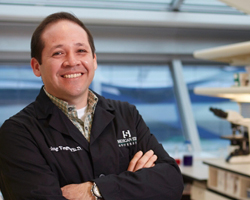Fighting Alzheimer's Disease in the Latino Community

"Alzheimer's is a family disease that tests the family foundation," says Irving Vega, MSU College of Human Medicine.
- Irving E. Vega, Ph.D.
- Associate Professor, Department of Translational Science and Molecular Medicine
- College of Human Medicine
Irving Vega studies cell changes in neurodegenerative disorders. Recruited from the University of Puerto Rico, Vega's emphasis on Alzheimer's disease, translational research, training, and community-based interventions made him a solid addition to the College of Human Medicine expansion. He joined the University in September 2014, and is based in the new MSU Grand Rapids Research Center.
As a native of Puerto Rico, Dr. Vega is particularly interested in the high rate of Alzheimer's disease (AD) that affects Latinos, and the extra stressors it adds to those immigrants in the United States. His research has identified biomarkers that appear to be associated with Alzheimer's, and he is committed to translational research that has practical applications for communities.
"I have a biomedical mentality, so I regard myself as a biochemist, with a passion for the bench. But, for me, it is important to make outreach and engagement an action phrase. I want to be involved with the community, be present with them, and have them feel the commitment," said Vega.
Alzheimer's is a neurodegenerative disease that is widely considered the most common dementia. According to the national Alzheimer's Association, the disease accounts for 60 to 80 percent of dementia cases identified. It is a progressive disease that impairs memory and cognitive abilities, and is the sixth leading cause of death in the United States. It is not solely a symptom of the aging process. People who deal with AD grapple with a condition that is bewildering and frightening. And that, in turn, impacts their loved ones and caregivers.
What Happens When a Person has Alzheimer's Disease
Where are my keys/eyeglasses/wallet/? Did I turn off the oven? What time did you say we had to be there?
Forgetfulness is a way of life. It happens to people who are preoccupied, busy, or inattentive. It also occurs when people are stressed, in a hurry, or feeling ill. Healthy adults who are in those momentary circumstances can often stop and focus, locate the lost item or recollect the details, and then move on. But when do memory lapses become a concern?
Simply stated by the Alzheimer's Association, the disease causes brain cells to malfunction—and die. This causes memory loss, personality changes, erratic behavior, and loss of critical body functions.
The cruel ramifications of AD can cause patients to lose their ability to talk, walk, eat, or recognize and communicate with family and friends.

"I want to be involved with the community, be present with them, and have them feel the commitment," says Irving Vega.
The MSU Grand Rapids Research Center and the Vega Laboratory
The Research Center, which opened in the fall of 2017, is the newest facility on the Grand Rapids Medical Mile. Located next to the Secchia Center, the headquarters for MSU's College of Human Medicine that opened in 2010, the Research Center is a six-story building that houses and supports scientific teams who focus on addressing complex health challenges and delivering therapeutic treatments to clinicians and their patients.
Some of those researchers were previously housed at the Van Andel Institute, a research institution founded in 1996 that provided the foundation for Medical Mile. Parkinson's disease, Alzheimer's disease, pediatric neurology, autism, inflammation, cancer, and genetics are among the areas of scientific study.
The process that damages cells and causes cells to die is not yet fully understood. According to the National Institutes of Health, the brain of an Alzheimer's patient contains abnormal levels of a naturally occurring protein called beta-amyloid 42 that is considered to be especially toxic. The protein clumps together to form plaques that collect between neurons and disrupt cell function.
The Vega Laboratory focuses on understanding changes in protein abundance in the course of neurodegeneration. The identification and characterization of affected proteins will help us understand why neurons stop functioning, lose connections to other neurological networks, and die off. Thus, the main goal is to conduct experiments to characterize the molecular mechanisms that lead to protein level changes that affect neurodegeneration.
Higher Rates of Alzheimer's Disease in Latinos−and Rising
In an article published in June 2017 for the Journal of Alzheimer's Disease, Vega brings attention to the intersection between social determinants of health and genetic factors associated with AD within the Latino community. While multiple reports point to Alzheimer's disease prevalence among blacks and Latinos, Vega acknowledges that these disparities are not yet understood, and can be regarded as controversial.
Latinos/Hispanics are the fastest growing population in the United States, based on statistics from the U.S. Census Bureau. According to the 2000 and 2010 census reports, the number of Latinos increased nearly 60 percent in one decade. Vega points to the diversity of the Latino population living in the United States (currently listed as more than 55 million) and supports further research in four Latino clusters, including Mexican, Central American, South American, and Caribbean.
Epidemiological data estimates that Latinos are 1.5 times more prone to develop AD than Caucasian non-Hispanics. Vega maintains that the broad categorization of Latinos needs further scrutiny because different symptomatology and prevalence of AD and related dementias among different Latino cohorts have been reported. He poses the question: Are ethnic, social, and economic factors potential contributors to the disparity in AD prevalence?
"From a neuroethics perspective, if we understand the challenges that influence health disparities in the Latino communities and other cultural populations, we can increase education and promote programs that meet their needs more effectively," said Vega.
The Latino Community in Grand Rapids and West Michigan
"It's typical for this community to look at someone who will build lasting relationships,"
José Reyna, Spectrum Health-Healthier Communities
Since his arrival, Dr. Vega has set out to establish connections with the West Michigan Latino community.
Grand Rapids has a vibrant Latino population—the largest minority group in the city—and Latinos have a strong presence in the surrounding West Michigan area. Vega is working to build relationships with community partners, both personally and professionally. He and his wife have two daughters in area schools, belong to a church, and have become familiar with local events and festivities.
"This is our community now, too. You have to be involved, and you have to stay involved," said Vega. "That is how you build trust."
José Reyna is the director of community health programs for Spectrum Health–Healthier Communities. He works with Vega to connect community members to resources. "Any sort of relationship that people in West Michigan seek is long-term and multi-faceted. They care about helping others, and they care about doing that in a variety of ways. It's typical for this community to look at someone who will build lasting relationships, rather than someone who comes in with one single purpose, and then goes out again," said Reyna.
For obvious reasons, Latinos are cautious when it comes to dealing with people outside their circle of family and friends. There are tight bonds and a sense of protectiveness that have developed from their hardship and hard work to establish a safe and secure life in the United States. The current political climate has increased apprehension about government policies and viewpoints from outsiders.
"I cannot expect people to tell me about their health or their loved ones' health issues unless they can trust me, and know that I want to make things better," said Vega.
For Vega and the other College of Human Medicine researchers, translational medicine connects research and knowledge with practical applications, so that people understand more about disease prevention, diagnosis, and treatment.
Added Burdens
Language barriers are another hurdle. If their English is not strong, Alzheimer's patients can experience frustrating interactions when describing their needs or understanding methods of care.
Sara Proaño is the director of language services at the Hispanic Center of Western Michigan. She is responsible for a team of Spanish interpreters and translators who work to resolve communication barriers in a variety of community settings, including the health care and legal sectors. While Spanish is their specialty, they also offer services for additional Latin-American languages and dialects. She recognizes the importance of academic connections, and what research and education can contribute to the well-being of individuals and families.
Proaño views MSU's investment in Grand Rapids and the surrounding area as an asset that will flourish if the researchers work with local stakeholders such as the Hispanic Center.
"This is where theory becomes practice so that we can help the community," said Proaño. "We are not interested in short-term research goals; we are trying to create collaborations that are sustainable. The bridges we build, we hope they are permanent."
AD Is a Family Disease
"Our culture is centered on family, so a disease like Alzheimer's is a family disease that tests the family foundation," said Vega.
Key findings from a 2016 study[3] by the USC Edward R. Roybal Institute on Aging and the LatinosAgainstAlzheimer's Network and Coalition found:
- The number of Latinos with AD is expected to increase more than ninefold from 379,000 in 2012 to 1.1 million by 2030, and to 3.5 million by 2060—a projected growth of 832 percent.
- Total direct and indirect costs for Latinos with AD will cost the U.S. economy a total of $2.35 trillion through 2060.
- Indirect costs for Latinos with AD, including unpaid informal care and earnings lost by persons with AD, are projected to increase tenfold by 2060.
- Latino families are less likely to use formal care services such as nursing home care and hospice care.
The research that Vega conducts is dependent on the cooperation of patients and their families who are struggling with the day-to-day impact of AD.
"It's not easy to open your lives for research, but I talk about the benefits of discovering new information about the disease. Yes, I tell them it's true that it may not help them immediately, but what we learn now can be useful to society—and family members—in the future. Maybe we can reduce risk. Maybe we can find better healthcare strategies," said Vega.
Vega is clear about his purpose: "We collect the data today and maybe it doesn't benefit someone right away—it's a long commitment. But it's my job to explain how important it is and what progress we might gain from their participation."
Sources
- Vega, Irving, Cabrera, L. Y., Wygant, C. M., Velez-Ortiz, D., & Counts, S. E. (2017). Alzheimer's disease in the Latino community: Intersection of genetics and social determinants of health. Journal of Alzheimer's Disease, 58, 979-992. Retrieved from https://content.iospress.com:443/journals/journal-of-alzheimers-diseaseBack to Article
- Krogstad, J. N. (2016, September 8). Key facts about how the U.S. Hispanic population is changing. Fact Tank: News in the Numbers [online report series]. Washington, DC: Pew Research Center. Retrieved from http://www.pewresearch.org/fact-tank/2016/09/08/key-facts-about-how-the-u-s-hispanic-population-is-changing/Back to Article
- Wu, S., Vega, W., Resendez, J., & Jin, H. (2016, June). Latinos and Alzheimer's Disease: New Numbers Behind the Crisis. Los Angeles: University of Southern California, Edward R. Roybal Institute on Aging, and the LatinosAgainstAlzheimer's Network. Retrieved from https://www.ucdmc.ucdavis.edu/latinoaging/images/pdf/Latinos-and-AD_USC_UsA2-Impact-Report.pdfBack to Article
- Written by Carla Hills, University Outreach and Engagement
- Photograph courtesy of MSU Communications and Brand Strategy